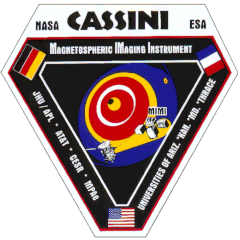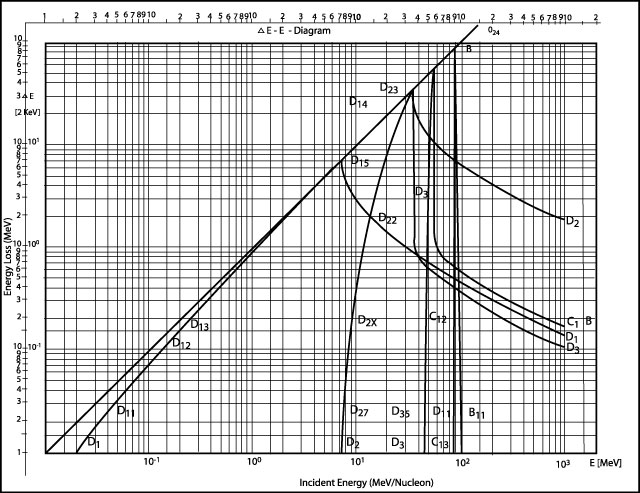Cassini MIMI Investigation at Fundamental Technologies
Historical MIMI Memos and Notes
Fax to E. Kirsch, S. Livi, B. Wilkin, and D. Mitchell, from T. Armstrong, 11/17/92
Program calculation of ion responses for your proposed MIMI 180º end detectors. I can easily adjust the logic, thicknesses, thresholds, etc. Please check that this is what you intended. I may have misread. Let me know what next.
Kirsch Proposal for MIMI 180º End, as of Sept. 29-Oct. 1 Team Meeting at CESR:
| ABSORBER NAME | Foil | D1 | D2 | D3 | Brass | C | B |
| ABSORBER THICKNESSES, MICRONS | 100.0 | 300.0 | 5000.0 | 300.0 | 2860.0 | 500.0 | 985.0 |
| ABSORBER MATERIAL | ALUM. | SILICON | SILICON | SILICON | NICKEL | SILICON | SILICON |
| THICKNESS VARIATION, MICRONS | 0.0 | 10.0 | 0.0 | 10.0 | 0.0 | 10.0 | 10.0 |
| CONICAL HALF ANGLE, DEGREES | 22.5 | 22.5 | 22.5 | 22.5 | 22.5 | 22.5 | 22.5 |
| DETECTOR NOISE, MEV | 0.0 | 0.015 | 0.0 | 0.015 | 0.0 | 0.010 | 0.010 |
| ELECTRONIC NOISE, MEV | 0.0 | 0.0 | 0.0 | 0.0 | 0.0 | 0.0 | 0.0 |
| NUMBER OF THRESHOLDS SET | 0.0 | 5.0 | 5.0 | 1.0 | 0.0 | 2.0 | 3.0 |
| THRESHOLD LEVEL NO. MEV 1 | 0.0 | 0.025 D11 |
0.026 D21 |
0.025 D31 |
0.0 | 0.025 C1 |
0.100 B1 |
| THRESHOLD LEVEL NO. MEV 2 | 0.0 |
0.110 D12 |
0.200 D2X |
0.0 | 0.0 | 0.200 C2 |
1.000 B2 |
| THRESHOLD LEVEL NO. MEV 3 | 0.0 | 0.200 D13 |
1.900 D22 |
0.0 | 0.0 | 0.0 | 10.00 B3 |
| THRESHOLD LEVEL NO. MEV 4 | 0.0 | 7.500 D14 |
35.00 D23 |
0.0 | 0.0 | 0.0 | 0.0 |
| THRESHOLD LEVEL NO. MEV 5 | 0.0 |
30.00 D15 |
150.0 D24 |
0.0 | 0.0 | 0.0 | 0.0 |
| AVERAGE PROJECTED DEPTH, MIC | 104.0 | 311.9 | 5197.8 | 311.9 | 2973.2 | 519.8 | 1024.0 |
| EST.RMS VARN.PROJ.DEPTH, MIC | 4.1 | 12.4 | 206.0 | 12.4 | 117.8 | 20.6 | 40.6 |
| NET RMS THICKNESS VARN. (MIC) | 4.1 | 15.9 | 206.0 | 15.9 | 117.8 | 22.9 | 41.8 |
| LOWER LIMIT THICKNESS (MIC) | 99.8 | 296.0 | 4991.8 | 296.0 | 2855.3 | 496.9 | 982.2 |
| UPPER LIMIT THICKNESS (MIC) | 108.1 | 327.8 | 5403.8 | 327.8 | 3091.0 | 542.7 | 1065.8 |
Fax reply from E. Kirsch, 12/9/92
I thank you very much for the program calculations concerning the LEMMS high energy detector. In the meantime I have improved the design and discussed it also with B. Wilken and S. Livi.
Could you please run the program once more for the new logic and the absorber and discriminator thresholds which I have listed separately.

LEMMS B-C-D Detectors
1. Electrons and X-rays
| D11· D12 · D21 · D2x = e- = 375 - 550 keV |
| D11· D12 · D2x · D22 = e- = 0.550 - 2.25 MeV |
| D11· D12 · D22 · D23 · D31= e- = 2.25 - 3.85 MeV |
| D11· D12 · D21 · D31 · C11 · B11 = 7.5 - 19.65 MeV |
| D11· D12 · D21 = e-, X = 25 - 200 keV = single rate D11 |
| Σ = 5 channels |
2. Protons and X-rays
| D11· D13 · D21 · D22 = 7 - 8.9 MeV p |
| D11· D13 · D22 · D23 · D31 = 8.9 - 35 MeV p |
| D11· D13 · D31 · C11 = 35 - 60 MeV p |
| D11· D13 · D21 · C11 · B11 = 55 - 100 MeV p |
| D11· D13 · D21 · D31 · C12 = 55 - 500 MeV p |
| D11· D21 · D22 · D31 = X = 25 - 200 keV X = single rate D21 |
| Σ = 6 channels |
3. α Particles
| D13· D14 · D21 · D23 = α = 28 - 63 MeV |
| D13· D14 · D23 · D31 = α = 63 - 130 MeV |
| D13· D14 · D31 · C11 = α = 130 - 230 MeV |
| Σ = 3 channels |
4. Z>= 3-Particles
| D14 · D21 · D23 ~= 35 - 70 MeV |
| D14 · D21 · D23 ~= 70 - 140 MeV |
| Σ = 2 channels |
5. Single rates D31, C11
Total: 18 channels
| D11 = 0.025 MeV | D21 = 0.025 MeV | D31 = 0.025 MeV |
| D12 = 0.2 MeV | D2x = 0.2 MeV | C11 = 0.025 MeV |
| D13 = 7.5 MeV | D22 = 2.0 MeV | C12 = 0.25 MeV |
| D14 = 30 MeV | D23 = 35 MeV | B11 = 0.025 MeV |
Absorber 1 = 100μ Al
Absorber 2 = 300μ Si
Detector D1
Absorber 3 = 5000μ Si
Detector D2
Absorber 4 = 300μ Si Detector
D3
Absorber 5 = 3000μ brass
Absorber 6 = 500μ Si
Detector C1
Absorber 7 = 3000μ Pt
Absorber 8 = 1000μ Si
Detector B1
ρPt=21.45 g/cm3
ρAu=19.32 g/cm
t=3000μ Pt =3000 · (21.45/19.32) Au
=3307μ Au
100μ = 100 x 10-4 cm = 0.01 cm
.3 cm Brass = 2.55 g/cm2 [8.5 g/cm2=r]
Nickel = 8.9 g/cm3
t = 2.55 g/cm2 / 8.9 g/cm3 = .286
cm
Return to Historical MIMI Notes and Memos main page.
Return to Cassini
MIMI table of contents page.
Return to Fundamental
Technologies Home Page.
Updated 8/8/19, Cameron Crane
QUICK FACTS
Mission Duration: The Cassini-Huygens mission launched on October 15 1997, and ended on September 15 2017.
Destination: Cassini's destination was Saturn and its moons. The destination of the Huygens Probe's was Saturn's moon Titan.
Orbit: Cassini orbited Saturn for 13 years before diving between its rings and colliding with the planet on September 15th, 2017.





